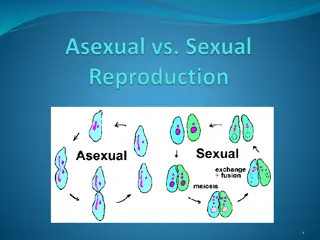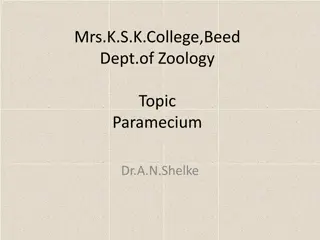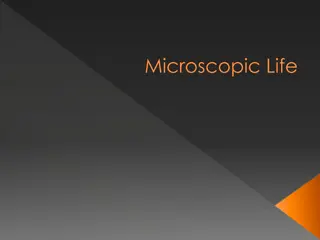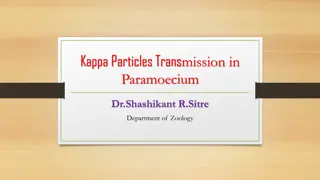Understanding Asexual Reproduction in Organisms
Asexual reproduction requires only one parent, resulting in offspring that are exact clones of the parent, with the same DNA and chromosomes. This method is common in one-celled organisms and involves processes like binary fission, plant cuttings, budding, fragmentation, and regeneration. Various or
1 views • 13 slides
Unveiling the World of Unicellular Organisms
Discover the fascinating world of unicellular organisms through examples like Amoeba and Paramecium. Compare the characteristics and functions of unicellular and multicellular organisms, explore their feeding, movement, waste removal, and reproduction processes, and delve into the diversity of cell
0 views • 14 slides
Exploring the Diverse World of Protists Through Microscopic Observations
During this lab exercise, a wide variety of protists were observed, showcasing the diverse characteristics and behaviors within this group. The classification of protists is continuously evolving, focusing on convenience rather than evolutionary relationships. From autotrophs to heterotrophs with an
0 views • 20 slides
Understanding Protozoa: The Animal-Like Unicellular Organisms
Protozoa are unicellular heterotrophic organisms that obtain nutrition by ingesting other organisms or dead organic material. They can be parasitic and are classified based on their modes of locomotion. Common groups include amoebas, flagellates, sporozoans, and ciliates. Protozoa are further catego
0 views • 16 slides
Exploring the Fascinating Kingdom Protista: Classification and Characteristics
Dive into the diverse world of Kingdom Protista, encompassing a wide range of eukaryotic organisms not classified under animals, plants, or fungi. Discover their classification based on nutrition acquisition and explore animal-like protists, such as zooflagellates, sarcodines, ciliates, and sporozoa
0 views • 21 slides
Exploring Paramecium: A Detailed Study of a Protozoan Organism
Paramecium, a widely studied protozoan organism, is found in various freshwater habitats. It exhibits unique characteristics such as locomotion through cilia, holozoic nutrition, and intracellular digestion. This microscopic organism reproduces both asexually and sexually, displaying a complex nucle
0 views • 8 slides
Understanding Logistic Growth in Population Dynamics
Explore the logistic growth equation and its applications in modeling population dynamics. Dive into the concept of sigmoidal growth curves and the logistic model, which reflects population growth with limits. Learn how to calculate population change using the logistic growth equation and understand
0 views • 26 slides
Exploring Microscopic Life Through a Microscope
Journey into the microscopic world by examining Elodea leaves and Paramecium under a microscope. Discover the intricate details of these tiny organisms, observe their movement, and learn about their structures. Engage in hands-on activities to explore the fascinating realm of microscopic life.
0 views • 16 slides
Understanding Kappa Particles Transmission in Paramecium
Research by Dr. Shashikant R. Sitre delves into the transmission of kappa particles in Paramecium, revealing the presence of these cytoplasmic particles in specific strains. The interaction between killer and sensitive strains, controlled by the dominant K gene, sheds light on cytoplasmic heredity a
0 views • 10 slides








